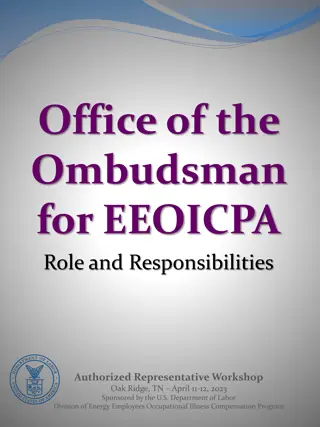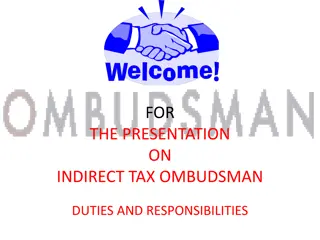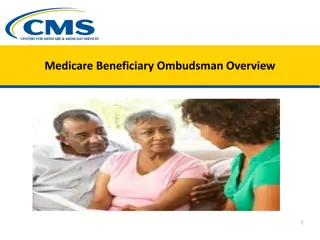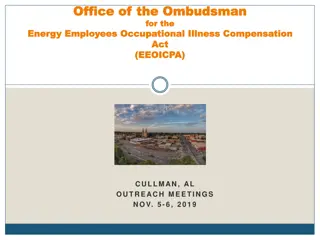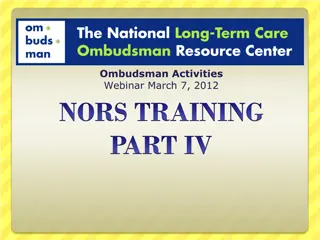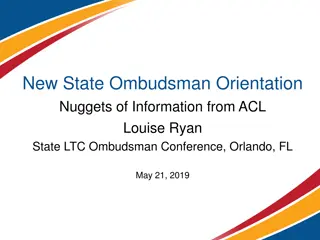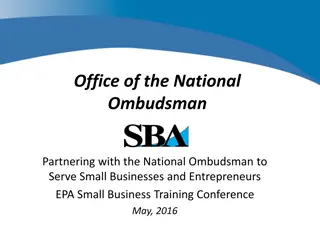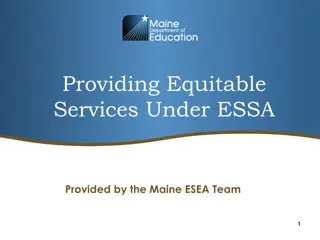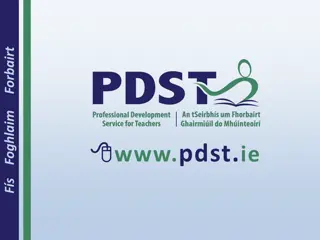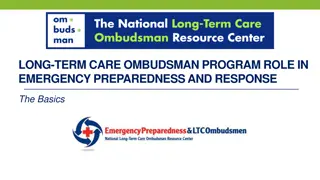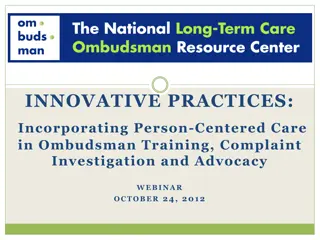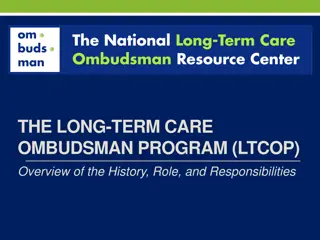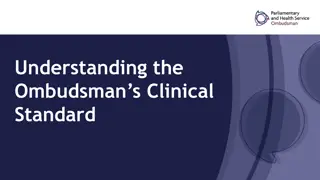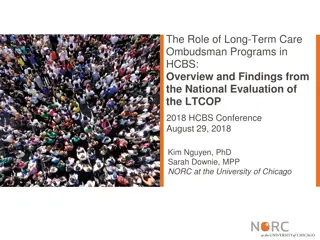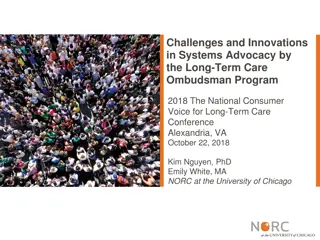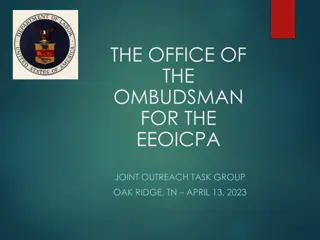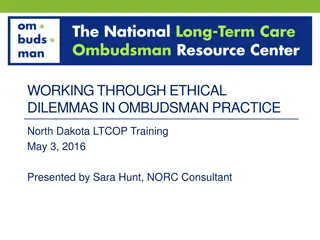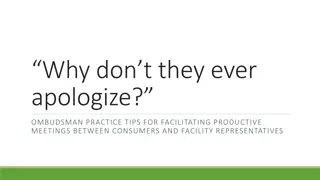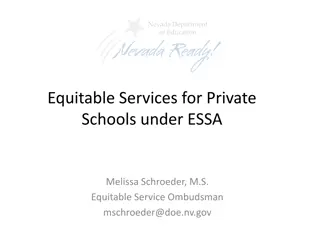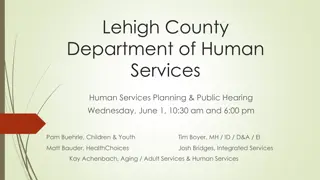Understanding the Role of Ombudsman in Minnesota's Human Services
An exploration of the role of Ombudsman in Minnesota, focusing on the functions and responsibilities of the Office of Ombudsman for Mental Health and Developmental Disabilities. Learn about the mission, people served, and the definition of an agency, facility, or program in relation to mental health services in the state.
Download Presentation

Please find below an Image/Link to download the presentation.
The content on the website is provided AS IS for your information and personal use only. It may not be sold, licensed, or shared on other websites without obtaining consent from the author. Download presentation by click this link. If you encounter any issues during the download, it is possible that the publisher has removed the file from their server.
E N D
Presentation Transcript
OMHDD Overview Senate Human Services Committee - January 18, 2023 1
What is an Ombudsman? Ombudsman is defined by the United States Ombudsman Association as: An independent, impartial public official with authority and responsibility to receive, investigate or informally address complaints about government (or government regulated agencies ) actions, and, when appropriate, make findings and recommendations, and publish reports. 2
OMHDD in Minnesota Established in 1987 Independent state agency Not part of DHS Ombudsman appointed by the Governor No term limit Nonpartisan Mission/Policy set by the Legislature Not a regulatory agency OMHDD staff/work Ten Regional Ombudsmen: Client services work and reviews of serious injury reports Medical Review Unit: Reviews of death reports 3
Mission Statement promote the highest attainable standards of treatment, competence, efficiency, and justice for persons receiving services for mental health, developmental disabilities, chemical dependency, or emotional disturbance. - Minnesota Statute section 245.92 4
People we serve Minnesotans with concerns or questions regarding services of an agency, facility, or program for: mental health developmental disabilities chemical dependency emotional disturbance This includes children and adults Anyone can contact OMHDD on behalf of themselves, family or friends, clients, or others 5
What is an Agency, Facility or Program? Agency: the divisions, officials or employees of the Departments of Human Services, Health, or Education, local school districts, or county social service agencies that monitor, provide, or regulate services or treatment for mental health, developmental disabilities, chemical dependency, or emotional disturbance Facility or Program: a residential or non-residential program or an acute care inpatient facility that provides clients with services or treatment that is required to be licensed, certified, or registered by DHS, MDH, or MDE 6
Why Call the Ombudsmans Office? Any person may call with Concern or complaint about services Question about client rights Question about an action of an agency or program Question about access to services or service options Question about the laws and rules that apply to services General question concerning other services/issues/programs 7
Client Services: Things the Ombudsmans Office can do Advocate on behalf of a client or group of clients or mediate among multiple client interests Consult with providers about policies, practices, and procedures Gather and analyze information Conduct reviews and investigations Review serious injury and death reports Visit programs Recommend corrective actions, issue reports, and monitor results Identify systemic issues and need for legislative action 8
Client Services: Priority Issues Unusual deaths or injuries of a client Situations of abuse or neglect Concerns about health, safety and welfare Quality of care or services received Violation of client rights Emergency Use of Manual Restraint Termination or suspension of services Access to appropriate services Practices that diminish client dignity, respect, productivity, community integration or independence Clients opportunities to direct and make choices about where they live, work and socialize Main focus: What s the severity/intensity, frequency, scope of the problem for our client(s)? 9
Reporting Deaths and Serious Injuries Minnesota Statute 245.94, Subd. 2a. Mandatory reporting Within 24 hours after a client suffers death or serious injury, the agency, facility, program director, or lead investigator of a clinical drug trial at the University of Minnesota Department of Psychiatry shall notify the ombudsman of the death or serious injury 10
Reviews of Death Reports (Medical Review Unit) Medical Review Unit: reviews each death report; determines appropriate level of review Medical Review Subcommittee (MRS): 5 members of our Governor-appointed Advisory Committee with medical expertise (at least 3 physicians, including 1 psychiatrist) Review deaths where treatment questions are identified Make recommendations Identify systemic problems Consult with agencies, licensing, other OMHDD staff Basic purpose/focus of work: Quality Assurance/Improvement (not licensure or liability) 11
What is a Serious Injury? Fractures Dislocations Evidence of internal injuries Head injuries with loss of consciousness or potential for a closed head injury or concussion without loss of consciousness requiring a medical assessment by a health professional, whether or not further medical attention was sought Lacerations involving injuries to tendons or organs Extensive second-degree or third-degree burns Extensive second-degree or third-degree frostbite 12
Serious Injury definition (continued) Irreversible mobility or avulsion of teeth Injuries to the eyeball Ingestion of foreign substances and objects that are harmful Near drowning Heat exhaustion or sunstroke Attempted suicide All other injuries and incidents considered serious after an assessment by a health care professional, including but not limited to self-injurious behavior, a medication error requiring medical treatment, a suspected delay of medical treatment, a complication of a previous injury, or a complication of medical treatment for an injury 13
Reviews of Serious Injury Reports (Regional Ombudsman staff) Timely, appropriate medical care Evidence of injury prevention efforts Coordination of care and follow up services Compliance with state laws, rules and relevant policies Appropriate treatment planning and risk management Adequacy of existing policies/practices/protocols Medication changes Staff training Access to appropriate residential options and supports Trends or clusters of similar system issues 14
Putting it in Perspective: OMHDD Total Cases, 10 Years Cases 14420 14182 10632 9732 8604 FY12-13 BIENNIUM FY14-15 BIENNIUM FY16-17 BIENNIUM FY18-19 BIENNIUM FY20-21 BIENNIUM Cases 16
Who/what does not qualify for OMHDD services? Criminal justice system and correctional facility issues Legal advocacy in court proceedings Social Security issues Veterans Affairs issues Any issue that does not meet definitions in OMHDD statutory definitions If a person does not qualify for services, we will try to find an appropriate referral. 17
Other OMHDD services and work Civil Commitment Training and Resource Center The Civil Commitment Training and Resource Center section contains fact sheets, notices counties must give to proposed patients and other info regarding commitment. Review of MDE, DHS and MDH licensing and maltreatment investigations Review of Emergency Use of Manual Restraints 245D.061 Oversight of University of Minnesota psychiatry clinical drug trials Minnesota Sex Offender Program client treatment/rights advocacy Policy and systemic advocacy 18
Questions? Website: Office of Ombudsman for Mental Health and Developmental Disabilities / Minnesota.gov (mn.gov) Contact info: General Questions - ombudsman.mhdd@state.mn.us Regional Ombudsman - Regional Listing or County Listing OMHDD phone numbers: 651-757-1800 or 1-800-657-3506 19
Thank you Barnett (Bud) Rosenfield Ombudsman Barnett.rosenfield@state.mn.us 20


